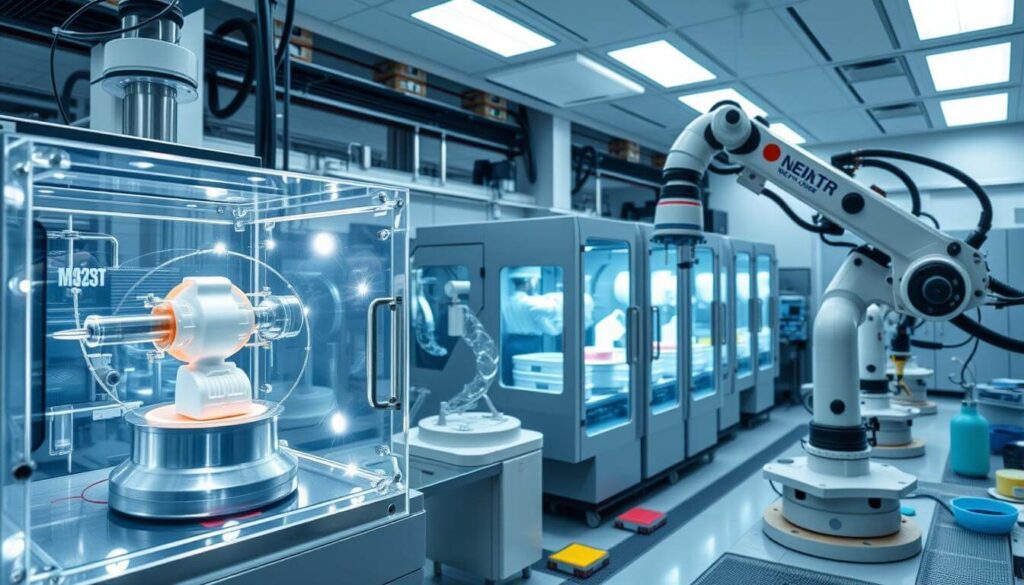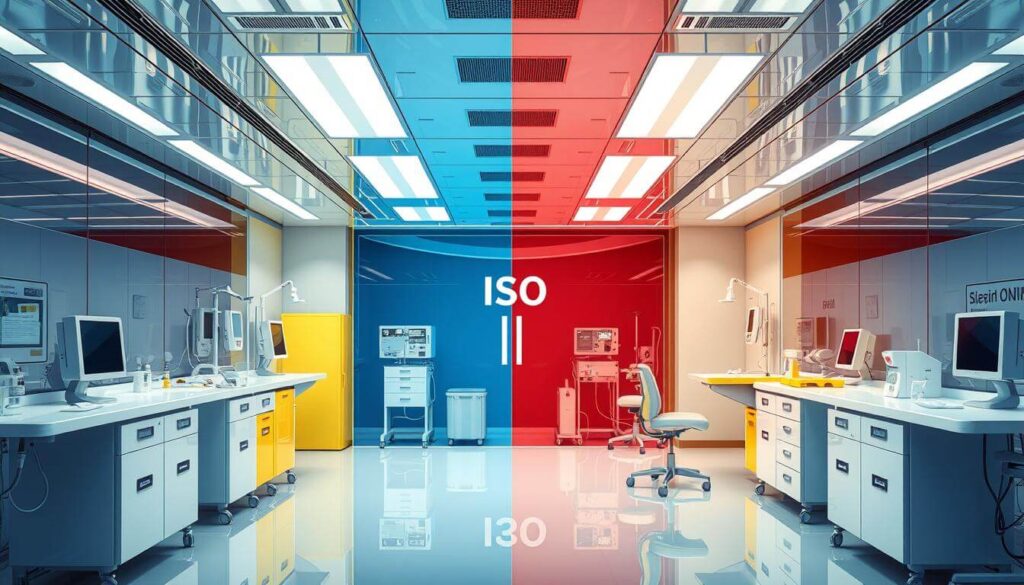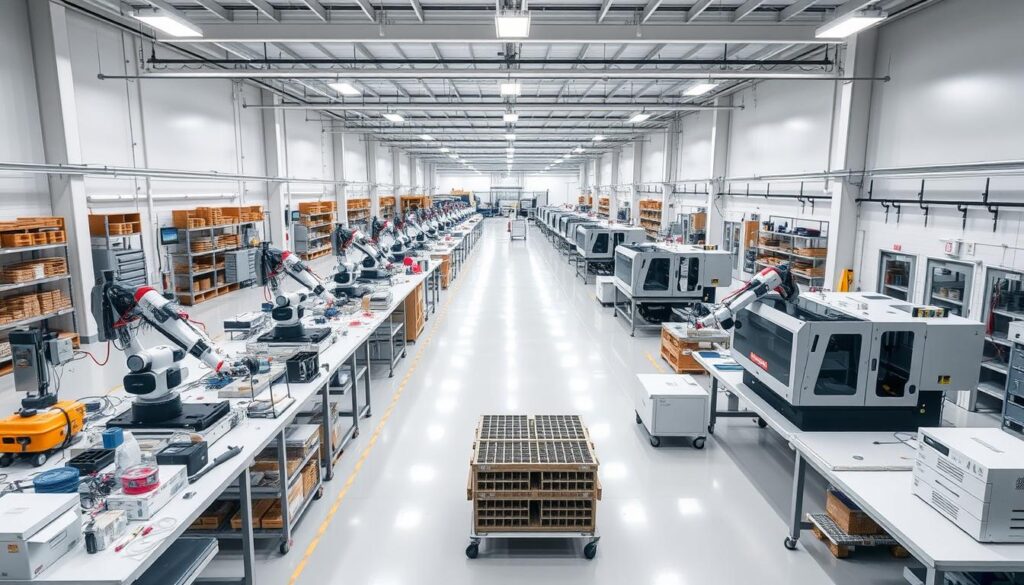
Medical device manufacturing is complex and requires a deep understanding of specialized processes. 医用注射成型是关键, allowing for the precise production of healthcare products. This guide explores the details of medical injection molding, covering manufacturing standards, core processes, 材料, 和 quality assurance.
If you’re in medical device engineering, 卫生保健, or just interested, this article is for you. It will give you the knowledge to understand the medical device manufacturing 世界. Learn about the latest advancements, the regulatory landscape, and strategies for improving production efficiency and patient outcomes.

要点
- Understand the critical manufacturing standards and regulations governing the medical device industry
- Explore the core processes and technologies involved in medical injection molding
- Discover the properties and applications of medical-grade polymers and biocompatible materials
- Learn about the importance of clean room requirements and contamination control in medical device production
- Gain insights into design considerations for optimizing medical device molding
- Dive into quality assurance protocols and testing procedures for ensuring product reliability
- Identify common challenges and strategies for cost optimization in medical device molding
Understanding Medical Device Manufacturing Standards
在医疗器械制造领域, following strict rules and quality checks is key. These rules help make safe, effective, and reliable medical products.
国际标准化组织 13485 Requirements and Compliance
国际标准化组织 13485 is a top standard for medical devices. It’s a quality management system for designing, making, and servicing medical devices. Following ISO 13485 means manufacturers stick to strict rules, keep good records, and always look for ways to improve. This ensures their devices are of high quality and meet all the rules.
FDA Regulations for Medical Device Production
The FDA also plays a big role in medical device making. They have strict rules for making, testing, and watching over medical devices. These rules help make sure devices are safe, work well, and are of high quality before they get to patients.
Quality Management Systems in Medical Manufacturing
Good quality management systems are essential for following medical device standards. These systems help keep processes steady, track product information, and fix any problems. They also help improve and follow 遵守 rules.
| 标准 | Key Focus | Compliance Benefits |
|---|---|---|
| 国际标准化组织 13485 | Quality management system requirements for medical devices | Ensures quality assurance, risk management, and continuous improvement |
| FDA Regulations | Premarket approval, good manufacturing practices (GMP), and post-market surveillance | Safeguards regulatory compliance and patient safety |
“Following industry standards and rules is not just a formality. It’s a key part of making medical devices. It ensures patient safety and product quality.”
医疗注塑: Core Processes and Technologies
In medical device making, injection molding is key. It ensures parts are precise, consistent, and can be made in large numbers. The machines used are special, designed for the medical field’s needs.
这 工装 is also vital. It includes advanced mold designs and cooling systems. These help make complex medical parts with great accuracy and finish. 这 process parameters like temperature and pressure must be controlled well to keep the product’s quality.
自动化 is important too. Robots and sensors help with handling materials and checking quality. This makes production more efficient and cuts down on mistakes. It helps meet the strict rules of the medical device world.
| Technology | 好处 |
|---|---|
| 专门 Injection Molding Machines | Precise control, 始终如一的品质, and scalable production |
| Advanced Tooling Techniques | Complex part design, superior surface finish, and dimensional accuracy |
| Automated Process Control | Increased efficiency, reduced errors, and compliance with regulations |
Using the newest 注塑机, 工装, 和 自动化 helps makers. They can create top-notch medical products. These products meet the high standards of the medical field.
Essential Materials for Medical Device Manufacturing
Selecting the right materials is a critical foundation in medical device development. From durable thermoplastics to flexible silicone elastomers, material properties influence everything from patient safety and comfort to device longevity and regulatory compliance. The use of biocompatible, sterilizable, 和 mechanically resilient materials ensures that medical devices can perform reliably in highly sensitive and demanding environments.
Medical-Grade Polymers and Their Properties
Medical-grade polymers offer a wide range of benefits due to their lightweight nature, 多功能性, and ability to be precisely engineered. Some of the most commonly used polymers include:
| Polymer | 主要特性 | 申请 | Pros | Cons |
|---|---|---|---|---|
| 聚乙烯 (聚乙烯醇) | High chemical resistance, 冲击强度 | Catheters, 管道, prosthetics | Inert, 灵活的, low cost | Limited heat resistance |
| 聚丙烯 (聚丙烯) | Fatigue resistance, 轻的 | 注射器, 容器, medical trays | Easy to mold, steam sterilizable | Brittle at low temperatures |
| 聚碳酸酯 (个人电脑) | Optical clarity, high impact strength | IV components, blood oxygenators | Transparent, autoclavable | Sensitive to stress cracking |
| 窥视 (聚醚醚酮) | 耐高温, excellent biocompatibility | Spinal cages, orthopedic implants | Radiolucent, long-term implantable | High cost, complex processing |
| 热塑性聚氨酯 (热塑性聚氨酯) | Elasticity, 耐磨性 | Flexible tubing, catheters | Transparent, kink-resistant | Limited long-term biocompatibility |
| Silicone Elastomers | 生物相容性, 热稳定性 | Wound drains, pacemaker leads, respiratory masks | Soft, 耐用的, ideal for skin contact | Lower tensile strength, requires special molding |
生物相容性: A Critical Requirement
Biocompatible materials are essential to ensure the device does not trigger an immune response or toxicity. Silicone remains one of the top choices due to its inertness, softness, and ability to be sterilized without degradation.
Testing for biocompatibility is guided by 国际标准化组织 10993 standards and includes:
Cytotoxicity tests – to assess cellular toxicity
Sensitization & irritation tests – to check for allergic or skin reactions
Systemic toxicity – to evaluate effects on internal organs
Implantation tests – to study long-term effects of implanted materials
Material Testing and Validation
Before any material is cleared for use in a medical device, it undergoes rigorous characterization and validation, 包括:
Mechanical testing (抗拉强度, 灵活性, fatigue)
Thermal testing (heat deflection, melting point, sterilization compatibility)
Chemical testing (leachables, extractables)
Biological testing (toxicity, reactivity, biodegradation)
These ensure not only the performance but also the safety and stability of the material across the product’s lifecycle.
Emerging Trends in Medical Material Science
The field of medical polymers continues to evolve, driven by innovation and new healthcare demands:
Bioresorbable polymers like PLGA and PLA are increasingly used in temporary implants and drug-delivery devices.
Smart materials, such as shape-memory polymers, are enabling responsive or programmable implants.
Antimicrobial-infused polymers are being developed to reduce hospital-acquired infections.
3D-printable medical polymers are expanding customization in surgical planning, prosthetics, and dental applications.
一个 2024 Journal of Biomedical Materials Research study highlighted a new hybrid TPU-silicone composite with improved flexibility and reduced bacterial adhesion—showing promising use for next-generation catheters and wound-care products.
“The selection of the right materials is the foundation of medical device manufacturing. It’s a delicate balance of science, 工程, and patient-centric design.”
Clean Room Requirements and Contamination Control
Keeping a clean and sterile environment is key in making medical devices. The rules for clean rooms in this field are very strict. Sterilization 和 aseptic processing are crucial for safe and effective medical products.
Medical device makers must follow strict ISO classifications. These standards set limits for airborne particles and microorganisms in clean rooms. The levels range from ISO Class 1, the strictest, to ISO Class 9, the least strict. Keeping these cleanliness levels is vital for making sterile, quality medical devices.
Effective contamination control strategies are used to prevent product contamination. This includes air filtration systems, strict staff rules, and deep cleaning and disinfection. Every detail matters, as small particles can harm the sterility and safety of medical devices.
还, medical device makers use strict sterilization techniques like gamma irradiation, ethylene oxide (EtO) treatment, or autoclaving. These methods are tested and watched closely to make sure they work well.
Keeping aseptic processing conditions is also key. This means using special clean room clothes, strict hygiene rules for staff, and special equipment and handling to avoid contamination.
By following these strict clean room rules and using strong contamination control, medical device makers can make safe, sterile, and high-quality products. These products meet the high standards of the industry.
Design Considerations for Medical Device Molding
Making high-quality medical devices needs careful design work. We’ll look at important parts like part design, tool engineering, and Design for Manufacturability (直接制造). These are key for making medical devices through injection molding.
Part Design Optimization
Optimizing part design is the first big step in molding medical devices. It uses advanced CAD/CAM tools to create designs that work well and are easy to make. Important things to think about are the part’s shape, thickness, and where features are placed. 这有助于 霉菌流量分析 and reduces mistakes.
Tool Design and Engineering
The mold tool’s design and engineering are very important for making consistent, 高品质零件. Things like where the gate is, the cooling system, and the materials used need careful planning. This ensures the right tolerance control and part performance.
Design for Manufacturability (直接制造)
Following DFM principles is crucial for successful medical device molding. It makes sure the design is good for making parts efficiently and at a low cost. It considers how parts are handled, assembled, 和 design validation 需要. Using DFM early helps avoid problems and makes production smoother.
“Successful medical device molding hinges on a comprehensive understanding of design optimization, tool engineering, and DFM principles.”
Quality Assurance and Testing Protocols
Keeping quality high is key in making medical devices. In medical injection molding, a strong quality program and strict testing are vital. They make sure the products are safe and work well. Let’s look at what makes this part of making products so important.
In-Process Inspection and Metrology
Checking products closely during making is crucial. In-process inspection 和 metrology help watch and measure important parts of the making process. 这边走, any problems can be found and fixed early.
Non-Destructive Testing for Validation
Non-destructive testing checks the quality and how well devices work without harming them. It lets makers check things like size, surface, and material without damaging the product.
这 validation step is key in making medical devices. Products go through tough tests to show they meet standards and rules. This makes sure healthcare workers and patients can trust the devices they use.
Medical injection molding companies use strong quality checks and tests to make sure devices are top-notch. This focus on quality helps the medical device world grow. It keeps patients safe and helps healthcare get better.
Common Challenges in Medical Device Molding
Creating medical devices with high precision and quality is tough. Manufacturers face many challenges in the injection molding process. These include getting perfect surface finishes and keeping tight dimensions.
As parts get more complex and use multiple materials, these challenges grow. It’s harder to mold parts with complex shapes and multiple materials.
Surface Finish Requirements
For medical tools and implants, the surface finish is key. It must be smooth and flawless. This is for both looks and safety.
To get the right finish, you need to control the molding process well. This includes the mold design and what happens after molding.
尺寸精度
Medical devices work in very sensitive places. Even small errors in size can be big problems. Keeping 紧张的公差 is crucial for safety and function.
This is especially true for micro-molding. Parts can be just a few millimeters big. Any mistake can be huge.
Material Flow Considerations
Medical device molding often deals with complex geometries 和 multi-material molding. Getting the material to flow right is hard. Complex shapes and extra materials can cause problems.
These issues need a deep understanding of molding. You also need to pay close attention to details. And always look for ways to improve.
By using new technologies and focusing on quality, makers can meet high standards. They can make medical parts that are safe and work well.
Cost Optimization and Production Efficiency
In the medical device manufacturing world, saving costs and improving production is key. 使用 精益制造, optimizing processes, and cutting waste can help a lot. 这边走, companies can keep their costs down and still make high-quality products.
Lean manufacturing helps by getting rid of waste and making production better. It finds and removes activities that don’t add value. This makes workflows smoother and saves money without lowering product quality.
Improving processes with predictive maintenance and real-time monitoring can also help. Cycle time reduction strategies, like better mold designs and automated systems, increase output. They also cut down on waste and make equipment work better.
| Optimization Strategy | 好处 |
|---|---|
| Lean manufacturing | Waste elimination, increased productivity, 节省成本 |
| 流程优化 | Improved quality, reduced downtime, enhanced throughput |
| Cycle time reduction | Faster turnaround, higher output, better resource utilization |
| Waste minimization | Reduced material consumption, lower energy usage, environmental sustainability |
通过使用这些策略, medical device makers can stay ahead. They can make more money and create products that meet healthcare needs.
“The key to achieving and sustaining a competitive edge in medical device manufacturing lies in the relentless pursuit of cost optimization and production efficiency.”
Learn more about our medical injection molding services
常问问题
Medical injection molding is a way to make medical devices and parts. It uses special plastic molding techniques. This process shapes medical-grade plastics into reliable, high-quality products.
The medical device industry follows strict rules to ensure safety and quality. Important standards include ISO 13485 and FDA regulations. Quality control is also a big part of it.
Advanced machines and special 工装 are used in medical injection molding. These tools help create detailed medical parts. 自动化 makes the process more precise and efficient.
Medical-grade polymers like 热塑性塑料 和 硅酮 are used. They are chosen for their 生物相容性. Testing these materials is crucial to meet industry standards.
Medical molding often happens in ISO-classified clean rooms. These rooms control contaminants and particles. Clean room practices are key to meeting healthcare standards.
Designing parts for molding is important. This includes optimizing part design and using advanced tool engineering. Design for Manufacturability (直接制造) principles also play a role.
Quality assurance and testing are thorough in medical molding. This includes inspections and advanced testing methods. These steps ensure product safety and performance.
Challenges include achieving precise finishes and maintaining 紧张的公差. Techniques like micro-molding help solve these problems. They also address complex part geometries.
To save costs and boost efficiency, 精益制造 is used. 流程优化 and reducing cycle times are also key. These methods help keep quality high while cutting waste.



If you are looking for somewhere to play, check out 7vvbetgame, I like the gameplay and UI could make it your place. 7vvbetgame
Gà chọi c1… yeah, still cockfighting. Different search term, same place. Definitely a niche thing. Dive in at your own risk. See for yourself: gà chọi c1
Thank you for your sharing. I am worried that I lack creative ideas. It is your article that makes me full of hope. Thank you. 但, I have a question, can you help me?